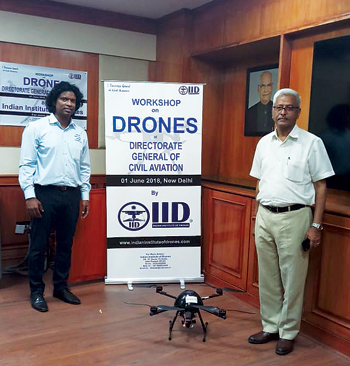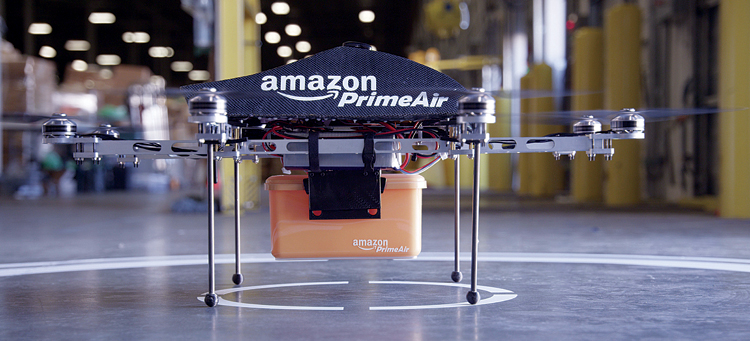India Declares Drone Policy
With the much awaited policy on operation of unmanned air systems (UAS) declared, the Indian aviation sector has entered a new era

On August 27 this year, the Ministry of Civil Aviation declared its policy to regulate operation of civilian drones. The policy will come into effect from December 1, 2018. The policy which has taken many years of deliberation, will have a paperless, all-digital registration process. The announcement was made by the Minister of Civil Aviation, Suresh Prabhu, in a press conference in the national capital. Speaking on the occasion, Suresh Prabhu said, “Today we start an exciting new chapter in India’s aviation history by allowing commercial use of drones. I am sure that many new and exciting applications will emerge that will propel India’s economy forward. Our progressive regulations will encourage a vast Made in India drone industry.”
“The Digital Sky Platform is the first-of-its-kind national unmanned traffic management (UTM) platform that implements no permission, no takeoff (NPNT). Users will be required to do a one-time registration of their drones, pilots and owners. For every flight (exempted for the nano category), users will be required to ask for permission to fly on a mobile app and an automated process permits or denies the request instantly,” Ministry of Civil Aviation said in a statement.
Talking about the policy, Minister of State for Civil Aviation, Jayant Sinha, said, “We want to establish a world-leading drone ecosystem. These regulations firmly place us among the global leaders. Our policy roadmap will certainly provide a strong impetus to all players in the drone ecosystem. We hope that these initiatives will enable us to create a vibrant new industry.”
To take things forward, a task force under the leadership of the Minister of State for Civil Aviation, Jayant Sinha, will recomend ‘Drone Regulations 2.0’
Describing the safety features of the policy, the statement said, “To prevent unauthorised flights and to ensure public safety, any drone without a digital permit to fly, will simply not be able to takeoff. The UTM operates as a traffic regulator in the drone airspace and coordinates closely with the defence and civilian air traffic controllers (ATCs) to ensure that drones remain on the approved flight paths.”
“Drone Regulations 1.0 is intended to enable visual, line-ofsight, daytime only and a maximum of 400 ft altitude operations. The air space has been divided into Red Zone (flying not permitted), Yellow Zone (controlled airspace) and Green Zone (automatic permission),” it added.
To take things forward, a task force under the leadership of the Minister of State for Civil Aviation, Jayant Sinha, will recommend ‘Drone Regulations 2.0’ which will be made after examining the “certification of safe and controlled operation of drone hardware and software, air space management through automated operations linked into overall airspace management framework, beyond visual-line-of-sight operations, contribution to establishing global standards and suggestions for modifications of existing CARs and/or issue of new CARs.”
Directorate General of Civil Aviation defining the drone, said, “Remotely Piloted Aircraft (RPA), autonomous aircraft and model aircraft are various sub-sets of unmanned aircraft. Unmanned aircraft system (UAS) is an aircraft and its associated elements, which are operated with no pilot on board.”
IID Becomes the First Drone Training Institute in India to Train DGCA Oficials

Indian Institute of Drones (IID) conducted a compact crash course workshop for DGCA officials and other government agencies involved in the regulatory frame work for drones in India on June 1, 2018. The institute is a registered nonprofit organization under the educational trust act India with Uttar Pradesh Government. In its 1 year 6 months of activity, Indian Institute of Drones has also started its franchises successfully and trained 500+ pilots in 9 cities and 5 countries.
Talking on another occasion, Lt Cdr John Livingstone, founder of Indian Institute of Drones, said, “There is a misconception about drones that they are banned in India. In reality, its use is just restricted.” Talking about career prospects in this field, Livingstone said, “These pilots are not restricted to flying drones, but are in high demand in aviation industry as well. Youngsters only have to be passionate and sharpen their skills to land a great opportunity.” In his speech, he said, “What task humans takes days or even months to complete, drones can bring it to half. SIM cards and GPS trackers make the impossible jobs possible, like locating dead bodies that are washed away or carrying out surveys in forests. It is a multidisciplinary technology that needs to be used to the fullest.” He said people need to be educated about the pros of a drone, and that it is not as hazardous as it is believed to be.
“Remotely piloted aircraft (RPA) is an unmanned aircraft, which is piloted from a remote pilot station. A remotely piloted aircraft, its associated remote pilot station(s), command and control links and other components, forms a Remotely Piloted Aircraft System (RPAS).”
The regulation has been issued under the provisions of Rule 15A and Rule 133A of the Aircraft Rules, 1937 and lays down requirements for obtaining Unique Identification Number (UIN), Unmanned Aircraft Operator Permit (UAOP) and other operational requirements for civil Remotely Piloted Aircraft System (RPAS).
According to the size, drones range from nano (few grams) to very large with payload capacity of hundreds of kilograms. Their ability to loiter over an area, with onboard sensors of various kinds, makes them an ideal platform for surveillance and reconnaissance. Since their development for military application, the world is witnessing their utilisation in various fields including photography, search and rescue, agriculture, policing and hobby flying.
The high demand, easy availability and ever-increasing flying capability of these systems called for regulations. Since these platforms can interfere and can pose danger to civilian and military aircraft and can be misused by anti-social elements, a definite policy with clear set of regulations, dishing out do’s and don’ts, was required. Home Minister Rajnath Singh, while inaugurating the 3-day Defence & Homeland Security Expo and Conference – 2018, said that the Government will soon implement the new Drone Policy containing comprehensive regulations on the use of drones. He said drones are being increasingly inducted into the Indian security establishment to monitor sensitive and vulnerable areas prone to security risks including thick and dense jungles in Left Wing Extremism (LWE) affected areas in which physical monitoring is extremely difficult.

For the last several years, the Ministry of Civil Aviation is working towards establishing a drone ecosystem in India rivaling the world’s best. This required a global standard drone regulations with appropriate safeguards in commercial application of various drone technologies.
Answering why it took so many years for the Ministry to churn out the policy, the statement said “Drone technologies have been evolving very rapidly and no ICAO standards have been developed. Moreover, India’s security environment necessitates extra precautions.”
Key features of Drone Regulations 1.0
As per the regulation, there are five categories of RPAS categorised by weight, namely nano, micro, small, medium and large. These are as under:
- Nano: Less than or equal to 250 grams.
- Micro: From 250 grams to 2kg.
- Small: From 2kg to 25kg.
- Medium: From 25kg to 150kg.
- Large: Greater than 150kg.
Operational/Procedural Requirements
All RPAS except nano and those owned by NTRO, ARC and Central Intelligence Agencies, are to be registered and issued with Unique Identification Number (UIN). Unmanned Aircraft Operator Permit (UAOP) shall be required for RPA operators except for nano RPAS operating below 50 ft, micro RPAS operating below 200 ft and those owned by NTRO, ARC and Central Intelligence Agencies.
The mandatory equipment required for operation of RPAS except nano category are (a) GNSS (GPS), (b) Return-To-Home (RTH), (c) Anti-collision light (d) ID-Plate, (e) Flight controller with flight data logging capability, and ( f) RF ID and SIM/ No- Permission No Take off (NPNT).
With the setting up a legal framework for comercial use of drones, it will help in developing the drones market and encourage investments for local production
As of now, RPAS are to operate within visual line of sight (VLoS), during day time only and up to maximum 400 ft altitude. For flying in controlled Airspace, filing of flight plan and obtaining Air Defence Clearance (ADC) /Flight Information Centre (FIC) number shall be necessary. Minimum manufacturing standards and training requirements of Remote Pilots of small and above categories of RPAS have been specified in the regulation. DGCA has to issue the UAOP within seven working days provided all the documents are complete. This UAOP shall be valid for five years and not transferrable. The policy also stipulates that RPAs shall be flown only by someone over 18 years of age, having passed 10th exam in English and undergone ground/practical training as approved by DGCA.
No Drone Zones
The regulation defines “No Drone Zones” around airports; near international border, Vijay Chowk in Delhi; State Secretariat Complex in State Capitals; strategic locations/vital and military installations etc.
Operations through Digital Platform
Operations of RPAS will be enabled through a Digital Sky Platform. The RPAS operations will be based on NPNT. The details including links for the digital sky platform shall be available in DGCA website from December 01, 2018. There will be different colour zones visible to the applicant while applying in the digital sky platform, viz, Red Zone: flying not permitted, Yellow Zone (controlled airspace): permission required before flying and Green Zone (uncontrolled airspace): automatic permission.
Enforcement Actions
The enforcement actions are (a) suspension/ cancellation of UIN/ UAOP in case of violation of regulatory provisions (b) actions as per relevant Sections of the Aircraft Act 1934 or Aircraft Rules or any statutory provisions and (c) penalties as per applicable IPCs (such as 287, 336, 337, 338, or any relevant section of IPC).
Drones offer multiple uses for infrastructure and natural resources sectors and are very useful in industries such as power, mining, realty, oil and gas exploration, railways and highways. Drones are an effective, low-cost and safe way of data collection through aerial surveys which are then used with big data and tools such as 3D modelling for businesses to simulate and analyse varied situations. E-commerce companies are exploring the possibilities of shipping goods through drones. Drones can be used for inspecting tall structures and offshore rigs. Relief, rescue work and policing can become more effective by using these platforms. Reaching out to upcountry and non-accessible areas becomes much easier and practical. Adoption of drones for commercial use is increasing in India and now with the setting up a legal framework for commercial use of drones, it will help in developing the drones market and encourage investments for local production.





